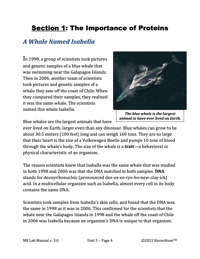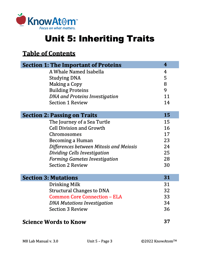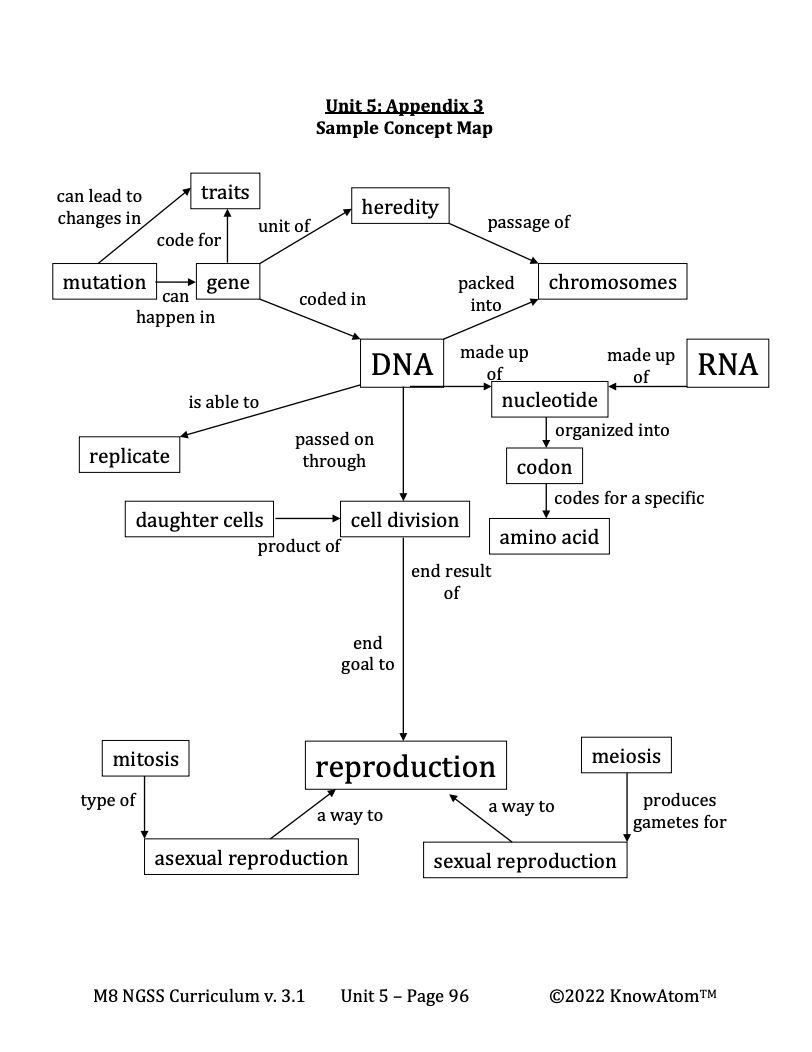Students explore the relationship between DNA and proteins, using a model to investigate how DNA’s structure allows it to make copies of its instructions for building specific proteins. These proteins in turn determine an organism’s traits.
In this unit, students investigate phenomena related to how organisms pass on traits to their offspring. Students begin, in this lesson, with an investigation into how DNA codes for proteins, which determine an organism’s traits. This page provides a high level overview of this lesson.
Science background gives teachers more in-depth information on the phenomena students explore. Below is an excerpt from this section on DNA and proteins.
All of your cells are constantly building and using proteins, and the instructions for making each protein are held in your DNA. For this reason, DNA has been called the instruction manual for how the cell should look and what it should do. DNA stands for deoxyribonucleic (pronounced dee-ox-ee-rye-bo-new-clay-ick) acid.
DNA is a polymer (a large molecule made up of many smaller molecules bonded together in a repeating chainlike pattern). These smaller molecules are called nucleotides. A nucleotide is itself made up of three types of molecules: a phosphate, a 5- carbon sugar, and a nitrogen-containing base. DNA gets its name from the sugar molecule, which is called deoxyribose. There are four nitrogen bases in DNA: adenine (A), thymine (T), guanine (G), and cytosine (C).
DNA has two strands that wind around each other, which makes the DNA molecule twist like a spiral staircase. This shape is why DNA is called a double helix. The sugar and phosphate molecules make up the sides of the staircase, and the nitrogen bases pair up to form the rungs. The base pairs follow a predictable pattern: A always links to T, and C always links to G. Because the bases are complementary, if you know the sequence of nucleotides on one side, you know the sequence of nucleotides on the other side. The base pairs are held together by hydrogen bonds.
DNA is universal to all living things. This means that the cells of every organism, including bacteria, plants, blue whales, and humans, store genetic information in molecules of DNA. The different sequences of nucleotides determine all of the differences among all organisms on Earth. This is because DNA contains the instructions that tell each cell how to make every protein it needs. It does this with genes. A gene is a specific pattern of nucleotides that produces a specific protein or set of proteins, which in turn determines an organism’s trait. In other words, each gene contains a specific structure of DNA that provides instructions for how to make one or a few related proteins. Genes are made up of hundreds or thousands of nucleotides.
Making proteins, also called protein synthesis, is a multi-stepped process that involves many parts of the cell. In order to understand these steps, it is important to remember that the cell is a dynamic place, and there is constant activity happening. Each organelle has a specific role to play in keeping the cell functioning properly.
Remember that the nucleus is the command center because it holds the DNA. This means the nucleus is the place where all of the instructions for building proteins are held. Proteins aren’t made in the nucleus, however, but on ribosomes, which are located on the rough endoplasmic reticulum or floating in the cytoplasm of the cell. This means that the instructions held in the DNA need to somehow get from the nucleus to the ribosomes.
This happens with the cell making a copy of the sequence of nucleotides that makes up a gene. To begin, special enzymes cause a part of the DNA to unwind and separate its two strands, unzipping down the middle. One strand can now be used as a template so that a copy of the instructions can be made and sent into the main part of the cell.
The copy is made with a polymer that is similar to but not exactly the same as DNA. This polymer is called RNA. Like DNA, RNA is made up of nucleotides, composed of sugar and phosphate molecules connected to nitrogen bases.
However, the sugar molecule in RNA is different from the sugar molecule in DNA. The RNA sugar molecule is called ribose, and it is how RNA gets its name—ribonucleic acid. And there is a small difference in the bases. Like DNA, RNA has guanine (G), adenine (A), and cytosine (C). However, RNA doesn’t have thymine. Instead, it uses uracil (U). The final difference is that RNA is a single strand, compared to DNA’s double strand. A kind of RNA called messenger RNA, or mRNA, makes the copy of the gene. The nucleotides of mRNA pair up with their complements on the strand of DNA: C and G pair up, and A and U pair up.
This process is called transcription, and it means “to make a faithful copy of.” Transcription produces a complementary strand of RNA that can be used to carry the instructions for building a particular protein out of the nucleus and into the cell.
Students explore the relationship between DNA and proteins, using a model to investigate how DNA’s structure allows it to make copies of its instructions for building specific proteins. These proteins in turn determine an organism’s traits.

Prepared hands-on materials, full year grade-specific curriculum, and personalized live professional development designed to support mastery of current state science standards.
Misconception: In sexually reproducing organisms, one parent contributes genes for some characteristics while the other parent contributes genes for other characteristics.
Fact: Both parents contribute genes for every characteristic in sexually reproducing organisms.
Amino acid : a molecule that is the building block of a protein; there are 20 amino acids
Codon : a sequence of three nucleotides on a mRNA molecule that encodes for a specific amino acid
DNA : deoxyribonucleic acid; a molecule that contains the genes for an organism’s traits and is passed on from parents to children
Gene : a specific pattern of nucleotides that produces a specific protein, which in turn codes for a trait
Nucleotide : a molecule that makes up DNA and RNA
RNA : ribonucleic acid; a molecule made up of a single strand of nucleotides
Trait : a physical or behavioral characteristic of an organism

A Whale Named Isabella
In 1998, a group of scientists took pictures and genetic samples of a blue whale that was swimming near the Galapagos Islands. Then in 2006, another team of scientists took pictures and genetic samples of a whale they saw off the coast of Chile. When they compared their samples, they realized it was the same whale. The scientists named this whale Isabella.
Blue whales are the largest animals that have ever lived on Earth, larger even than any dinosaur. Blue whales can grow to be about 30.5 meters (100 feet) long and can weigh 160 tons. They are so large that their heart is the size of a Volkswagen Beetle and pumps 10 tons of blood through the whale’s body. The size of the whale is a trait—a behavioral or physical characteristic of an organism.
The reason scientists knew that Isabella was the same whale that was studied in both 1998 and 2006 was that the DNA matched in both samples. DNA stands for deoxyribonucleic (pronounced dee-ox-ee-rye-bo-new-clay-ick) acid. In a multicellular organism such as Isabella, almost every cell in its body contains the same DNA.
Scientists took samples from Isabella’s skin cells, and found that the DNA was the same in 1998 as it was in 2006. This confirmed for the scientists that the whale near the Galapagos Islands in 1998 and the whale off the coast of Chile in 2006 was Isabella because an organism’s DNA is unique to that organism.
Studying DNA
Scientists who want to understand why an organism looks or behaves the way it does often begin with that organism’s DNA. This is because DNA holds the instructions for making all of the proteins needed to keep the organism functioning. Remember that proteins are large, complex molecules that play many important roles in the body. Scientists have identified more than 100,000 proteins, which have a wide range of functions. Everything that takes place in an organism is either made of proteins or is the result of an action caused by a protein.


For example, like humans, blue whales have an aorta, which is its main blood vessel. The aorta of the blue whale is so large that a human can crawl through. The aorta and all other blood vessels are made up of connective tissues. These connective tissues have highly elastic proteins that allow the tissues to regain their shape after they’ve been stretched or contracted. Elasticity is important for blood vessels because they are constantly stretched as blood flows through them. Hemoglobin is another complex protein that transports oxygen in blood.
Keratin is a structural protein that makes up your hair and nails. Keratin also makes up the filter-feeder system inside the mouths of blue whales that allows it to filter large amounts of water and food. Hormones are another group of proteins that regulate various functions. They do this by sending messages between cells to regulate the cell’s life functions. Still other proteins allow parts of cells to move and cause muscles to contract so animals can move from place to place.
All of your cells are constantly building and using proteins. And the instructions for making each protein are held in your DNA. This is why DNA has been called life’s instruction manual. DNA is a polymer (a large molecule made up of many smaller molecules bonded together in a repeating chainlike pattern). These smaller molecules are called nucleotides. A nucleotide is itself made up of three types of molecules: a phosphate, a 5-carbon sugar, and a nitrogen-containing base.
DNA gets its name from the sugar molecule, which is called deoxyribose. There are four nitrogen bases in DNA: adenine (A), thymine (T), guanine (G), and cytosine (C). DNA has two strands that wind around each other, which makes the DNA molecule twist like a spiral staircase. This shape is why DNA is called a double helix. The sugar and phosphate molecules make up the sides of the staircase, and the nitrogen bases pair up to form the rungs.
The base pairs follow a predictable pattern: A always links to T, and C always links to G. Because the bases are complementary, if you know the sequence of nucleotides on one side, you know the sequence of nucleotides on the other side. The base pairs are held together by hydrogen bonds.
There are several steps between the gene and the protein. Making proteins is called protein synthesis. It is a multi-step process that involves many parts of the cell. In order to understand these steps, it is important to remember that the cell is a dynamic place, and there is constant activity happening. Each organelle has a specific role to play in keeping the cell functioning properly.
In this lesson, students use a model to investigate phenomena of biological processes that allow the DNA in a cell to build specific proteins responsible for the phenomena of traits of an organism. Students use the results of their investigation to explain about how genetic information is stored and copied within a cell.
KnowAtom incorporates formative and summative assessments designed to make students thinking visible for deeper student-centered learning.

Standards citation: NGSS Lead States. 2013. Next Generation Science Standards: For States, By States. Washington, DC: The National Academies Press. Neither WestEd nor the lead states and partners that developed the Next Generation Science Standards were involved in the production of this product, and do not endorse it.
